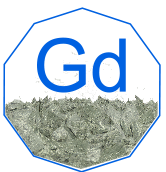Gadolinium

Gadolinium (Gd)
General Information
- Symbol: Gd
- Atomic Number: 64
- Atomic Weight: 157.25 u
- Element Category: Lanthanide
- Group: N/A (Lanthanides series)
- Period: 6
- Block: f-block
Physical Properties
- Appearance: Silvery-white metallic
- Density: 7.90 g/cm³
- Melting Point: 1313 °C (2395 °F)
- Boiling Point: 3273 °C (5923 °F)
- Phase at STP: Solid
- Electron Configuration: [Xe] 4f⁷ 5d¹ 6s²
- Oxidation States: +3 (most common)
Chemical Properties
- Reactivity: Gadolinium is fairly reactive, tarnishing slowly in air. It reacts with water to form gadolinium hydroxide and with acids to form gadolinium salts.
- Compounds: Forms compounds such as gadolinium(III) oxide (Gd₂O₃), gadolinium(III) chloride (GdCl₃), and gadolinium(III) nitrate (Gd(NO₃)₃).
Uses and Applications
- Magnetic Resonance Imaging (MRI): Gadolinium compounds are used as contrast agents to enhance the clarity of MRI scans.
- Nuclear Reactors: Used in control rods and shielding materials due to its high neutron absorption cross-section.
- Alloys: Added to improve the workability and resistance of various metals.
- Phosphors: Used in phosphors for color television tubes and fluorescent lamps.
- Magnets: Gadolinium-based alloys are used in the production of high-strength magnets.
- Research: Gadolinium compounds are used in various scientific research applications, particularly in material science and chemistry.
Occurrence and Extraction
- Natural Occurrence: Found in minerals such as monazite and bastnasite, often alongside other rare earth elements.
- Extraction: Extracted through complex processes involving the crushing of ore, magnetic separation, and solvent extraction.
Isotopes
- Stable Isotopes: Gadolinium-154, Gadolinium-155, Gadolinium-156, Gadolinium-157, Gadolinium-158, Gadolinium-160
- Radioactive Isotopes: Gadolinium-152, Gadolinium-153 (used in research)
Safety and Handling
- Hazards: Gadolinium compounds are considered to have low toxicity, but dust and powders should be handled carefully to avoid inhalation or ingestion. Metallic gadolinium can be a fire hazard in powder form.
- Precautions: Use appropriate protective equipment when handling gadolinium and its compounds.
History
- Discovery: Discovered by Jean Charles Galissard de Marignac in 1880.
- Name Origin: Named after the Finnish chemist Johan Gadolin.
Additional Facts
- Crystal Structure: Hexagonal close-packed (hcp) at room temperature
- Magnetic Properties: Paramagnetic, but becomes ferromagnetic below 20°C (68°F)
- Thermal Conductivity: 10.6 W/m·K
- Electrical Resistivity: 1.31 µΩ·m at 20°C
Summary
Gadolinium is a versatile lanthanide with a wide range of applications in industry, medicine, and research. It is particularly valuable as a contrast agent in MRI scans, in nuclear reactors, and in the production of high-strength magnets. Discovered in 1880 and named after Johan Gadolin, gadolinium is found in several minerals and requires careful handling due to its reactive nature.
40 Question and Answer Pairs About Gadolinium
What is the atomic number of Gadolinium?
- 64
What is the symbol for Gadolinium?
- Gd
What is the atomic weight of Gadolinium?
- 157.25 u
In which group of the periodic table is Gadolinium found?
- Lanthanides series (no specific group)
What period is Gadolinium in?
- Period 6
What block does Gadolinium belong to?
- f-block
What is the density of Gadolinium?
- 7.90 g/cm³
What is the melting point of Gadolinium?
- 1313 °C (2395 °F)
What is the boiling point of Gadolinium?
- 3273 °C (5923 °F)
What is the electron configuration of Gadolinium?
- [Xe] 4f⁷ 5d¹ 6s²
What are the common oxidation states of Gadolinium?
- +3 (most common)
What is the appearance of Gadolinium?
- Silvery-white metallic
Is Gadolinium reactive with air?
- Yes, it tarnishes slowly in air.
Name a compound of Gadolinium.
- Gadolinium(III) oxide (Gd₂O₃)
What is a common use of Gadolinium in medicine?
- As a contrast agent in MRI scans.
How is Gadolinium used in the nuclear industry?
- In control rods and shielding materials.
What role does Gadolinium play in alloys?
- Added to improve workability and resistance.
How is Gadolinium used in phosphors?
- In phosphors for color television tubes and fluorescent lamps.
What is a magnetic application of Gadolinium?
- In the production of high-strength magnets.
How is Gadolinium typically found in nature?
- In minerals such as monazite and bastnasite.
What are the stable isotopes of Gadolinium?
- Gadolinium-154, Gadolinium-155, Gadolinium-156, Gadolinium-157, Gadolinium-158, Gadolinium-160
What safety hazard is associated with Gadolinium dust?
- It can be a fire hazard.
Who discovered Gadolinium?
- Jean Charles Galissard de Marignac
Where does the name Gadolinium come from?
- Named after the Finnish chemist Johan Gadolin.
What is the crystal structure of Gadolinium?
- Hexagonal close-packed (hcp) at room temperature
Is Gadolinium paramagnetic or diamagnetic?
- Paramagnetic, but becomes ferromagnetic below 20°C (68°F)
What is the thermal conductivity of Gadolinium?
- 10.6 W/m·K
What is the electrical resistivity of Gadolinium at 20°C?
- 1.31 µΩ·m
What is the primary oxidation state of Gadolinium in its compounds?
- +3
Is Gadolinium found as a free element in nature?
- No, it is found in minerals.
What is the common name of Gadolinium(III) chloride?
- GdCl₃
What is a major application of Gadolinium in the MRI industry?
- As a contrast agent.
How does Gadolinium benefit the nuclear industry?
- As a neutron absorber in control rods and shielding.
What is the melting point of Gadolinium in Kelvin?
- 1586 K
What group does Gadolinium belong to in the periodic table?
- Lanthanides series
What is the natural abundance of Gadolinium-157?
- It is one of the stable isotopes.
Can Gadolinium be used in high-temperature applications?
- Yes, particularly in alloys and magnets.
What is the key property that makes Gadolinium valuable in MRI scans?
- Its paramagnetic properties, which enhance image contrast.
How is Gadolinium used in the chemical industry?
- Mainly in research and specialized applications.
What precautions should be taken when handling Gadolinium?
- Use appropriate protective equipment to avoid inhalation or ingestion.






